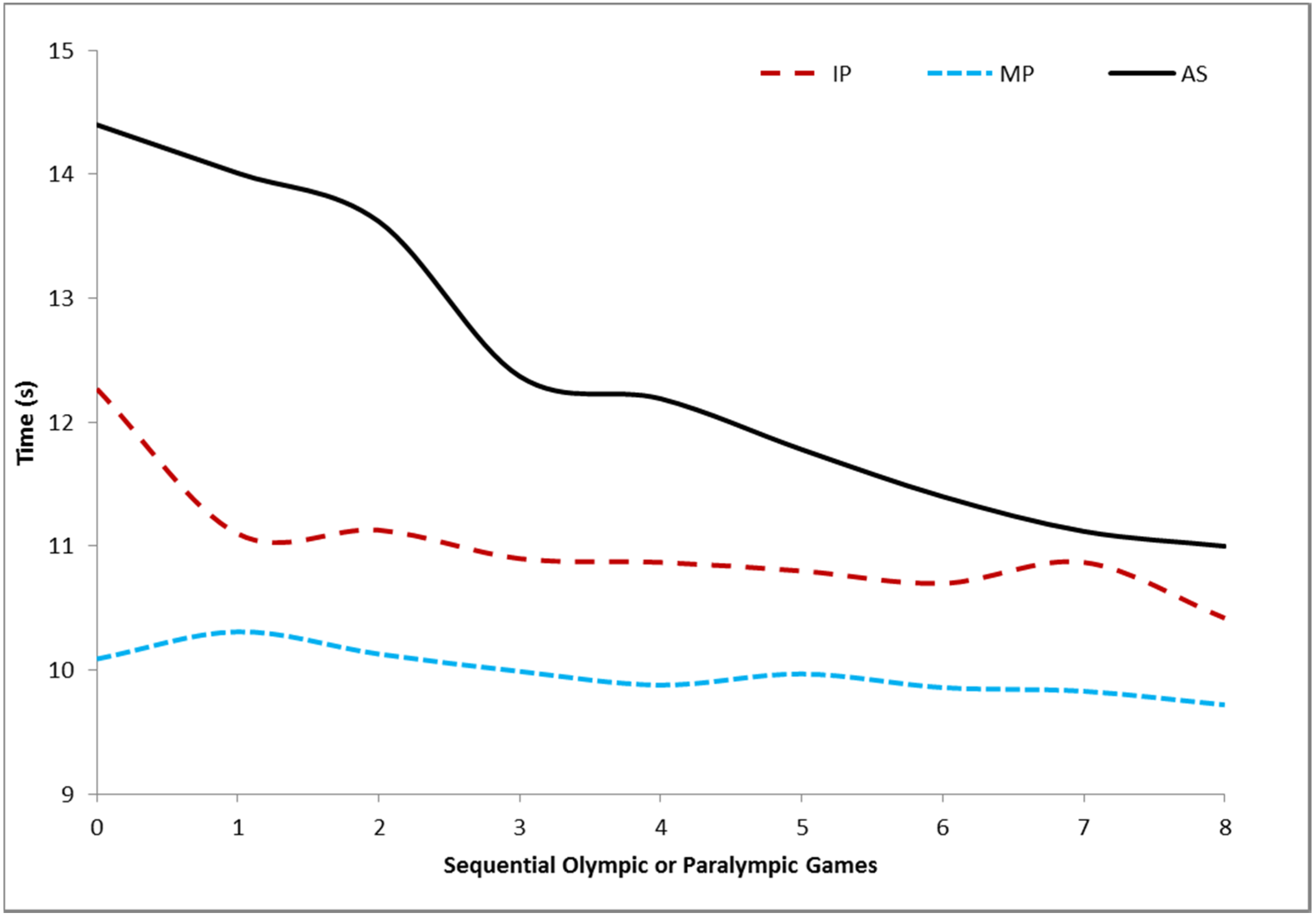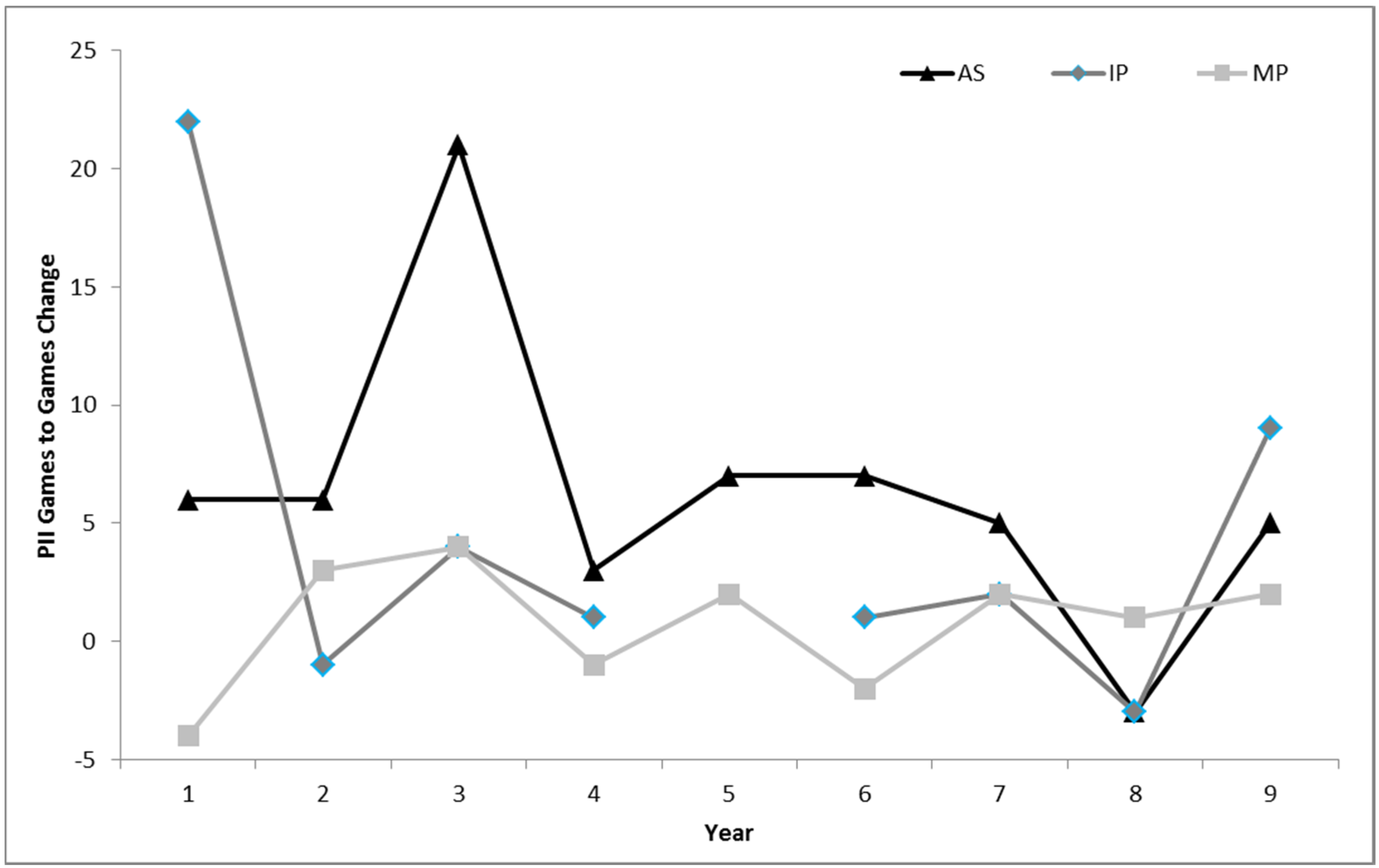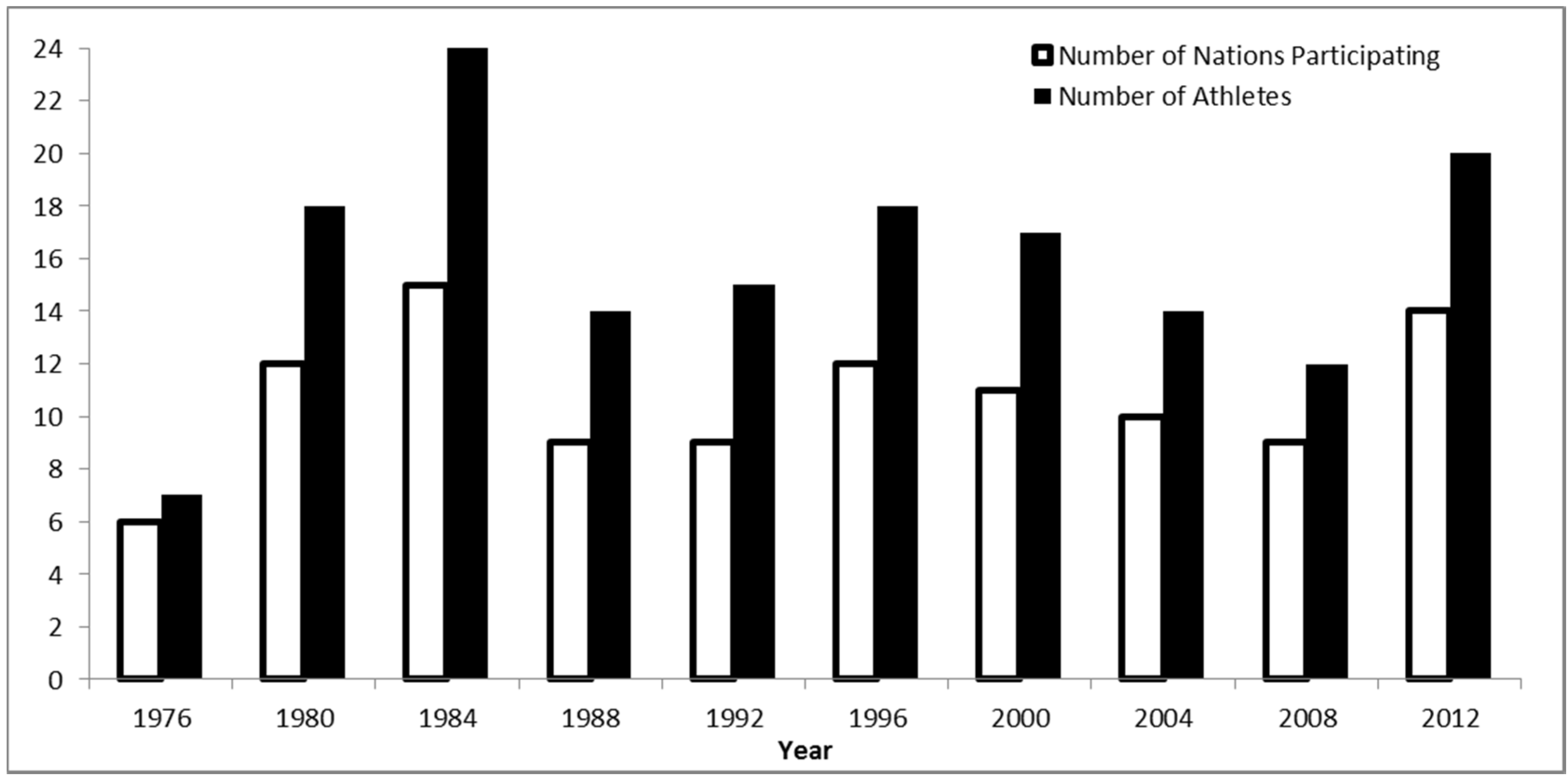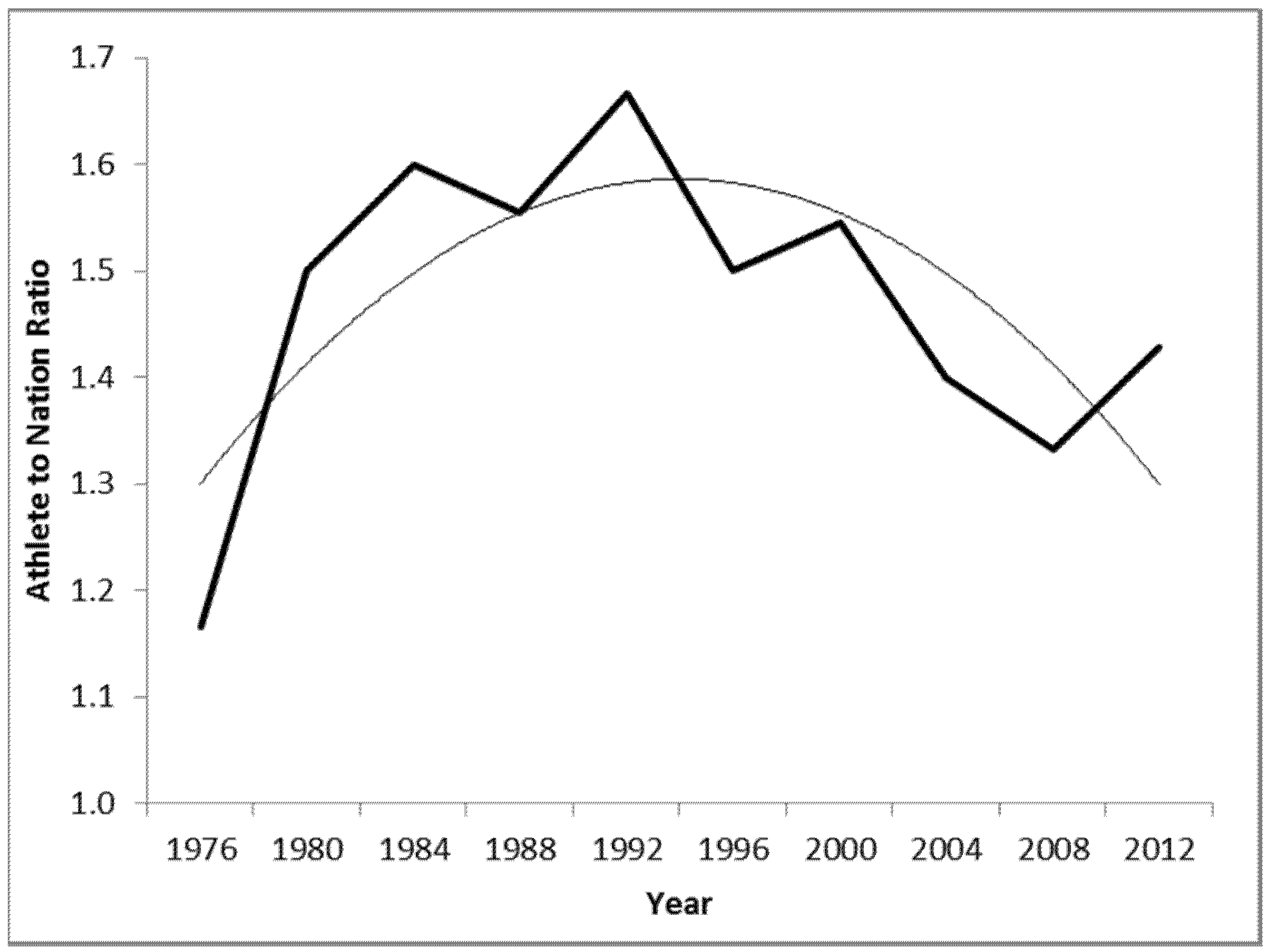The Progression of Male 100 m Sprinting with a Lower-Limb Amputation 1976–2012
Abstract
:1. Introduction
- MC (1976 and 1980)
- A4 (1984 and 1988)
- TS2 (1992)
- T44 (1996-current)
2. Methods
2.1. Performance Data
- Amputee sprinting (AS): The PII change from Paralympic Games to Paralympic Games over the 1976–2012 time period.
- Able-bodied Inception Period (IP): The change from Olympic Games to Olympic Games over the 1896–1932 time period.
- Able-bodied Modern Period (MP): The change from Olympic Games to Olympic Games over the 1976–2012 time period.
2.2. Event Participation
3. Results
3.1. Performance Improvement
3.1.1. Performance Improvement of AS
| Paralympic Games | Mean podium time (s) | Percentage improvement from prior games (%) | PII improvement from prior games (%) | PII improvement from 1976 baseline (%) |
|---|---|---|---|---|
| 1976 | 14.40 | - | - | - |
| 1980 | 14.01 | 2.7 | 6 | 6 |
| 1984 | 13.62 | 2.8 | 6 | 12 |
| 1988 | 12.37 | 9.2 | 21 | 36 |
| 1992 | 12.19 | 1.5 | 3 | 40 |
| 1996 | 11.78 | 3.4 | 7 | 49 |
| 2000 | 11.40 | 3.2 | 7 | 60 |
| 2004 | 11.12 | 2.5 | 5 | 68 |
| 2008 | 11.29 | −1.5 | −3 | 63 |
| 2012 | 11.00 | 2.6 | 5 | 71 |
3.1.2. Performance Improvement of Able-Bodied IP
| Olympic Games | Mean podium time (s) | Percentage improvement from prior games (%) | PII improvement from prior games (%) | PII improvement from 1896 baseline (%) |
|---|---|---|---|---|
| 1896 | 12.27 | - | - | 0 |
| 1900 | 11.10 | 9.5 | 22 | 22 |
| 1904 | 11.13 | −0.3 | −1 | 21 |
| 1908 | 10.90 | 2.1 | 4 | 27 |
| 1912 | 10.87 | 0.3 | 1 | 27 |
| 1920 | 10.80 | 0.6 | 1 | 29 |
| 1924 | 10.70 | 0.9 | 2 | 31 |
| 1928 | 10.87 | −1.6 | −3 | 27 |
| 1932 | 10.42 | 4.29 | 9 | 39 |
3.1.3. Performance Improvement of Able-Bodied MP
| Olympic Games | Mean podium time (s) | Percentage improvement from prior games (%) | PII improvement from prior games (%) | PII improvement from 1976 baseline (%) |
|---|---|---|---|---|
| 1976 | 10.09 | - | - | 0 |
| 1980 | 10.31 | −2.2 | −4 | −4 |
| 1984 | 10.13 | 1.7 | 3 | −3 |
| 1988 | 9.96 | 1.7 | 4 | 3 |
| 1992 | 9.99 | −0.3 | −1 | 2 |
| 1996 | 9.88 | 1.1 | 2 | 4 |
| 2000 | 9.97 | −0.9 | −2 | 3 |
| 2004 | 9.86 | 1.1 | 2 | 5 |
| 2008 | 9.83 | 0.3 | 1 | 5 |
| 2012 | 9.72 | 1.1 | 2 | 8 |


3.2. Event Participation


4. Discussion
5. Conclusions
Acknowledgments
Conflicts of Interest
References
- Gold, J.; Gold, M. Access for all: The rise of the Paralympic Games. J. R. Soc. Promot. Health 2007, 127, 133–141. [Google Scholar] [CrossRef] [PubMed]
- Nolan, L. Carbon fibre prostheses and running in amputees: A review. Foot Ankle Surg. 2008, 14, 125–129. [Google Scholar] [CrossRef] [PubMed]
- Tweedy, S.; Vanlandewijck, Y. International Paralympic Committee position stand—Background and scientific principles of classification in Paralympic Sport. Br. J. Sports Med. 2011, 45, 259–269. [Google Scholar] [CrossRef] [PubMed]
- Gutfleisch, O. Peg legs and bionic limbs: The development of lower extremity prosthetics. Interdiscip. Sci. Rev. 2003, 28, 139–148. [Google Scholar] [CrossRef]
- Burkett, B. Technology in Paralympic sport: Performance enhancement or essential for performance? Br. J. Sports Med. 2010, 44, 215–220. [Google Scholar] [CrossRef] [PubMed]
- Bruggemann, G.; Arampatzis, A.; Emrich, F.; Potthast, W. Biomechanics of double transtibial amputee using dedicated sprinting prostheses. Sports Technol. 2008, 1, 220–227. [Google Scholar] [CrossRef]
- Dyer, B.; Noroozi, S.; Sewell, P. Sprinting with an amputation: Some race-based lower-limb step observations. Prosthet. Orthot. Int. 2014. [Google Scholar] [CrossRef]
- Haake, S. The impact of technology on sporting performance in Olympic Sports. J. Sports Sci. 2009, 27, 1421–1431. [Google Scholar] [CrossRef] [PubMed]
- Foster, L.; James, D.; Haake, S. Understanding the influence of population size on athletic performance. Proced. Eng. 2010, 2, 3183–3189. [Google Scholar] [CrossRef]
- Balmer, N.; Pleasence, P.; Nevill, A. Evolution and revolution: Gauging the impact of technological and technical innovation on Olympic performance. J. Sports Sci. 2012, 30, 1075–1083. [Google Scholar] [CrossRef] [PubMed]
- Kyle, C. Ergogenics for bicycling. Perspect. Exercise Sci. Sports Med. 1991, 4, 373–413. [Google Scholar]
- Legg, D.; Steadward, R. The Paralympic Games and 60 years of change (1948–2008): Unification and restructuring from a disability and medical model to sport-based competition. Sport Soc. 2011, 14, 1099–1115. [Google Scholar] [CrossRef]
© 2015 by the authors; licensee MDPI, Basel, Switzerland. This article is an open access article distributed under the terms and conditions of the Creative Commons Attribution license (http://creativecommons.org/licenses/by/4.0/).
Share and Cite
Dyer, B. The Progression of Male 100 m Sprinting with a Lower-Limb Amputation 1976–2012. Sports 2015, 3, 30-39. https://doi.org/10.3390/sports3010030
Dyer B. The Progression of Male 100 m Sprinting with a Lower-Limb Amputation 1976–2012. Sports. 2015; 3(1):30-39. https://doi.org/10.3390/sports3010030
Chicago/Turabian StyleDyer, Bryce. 2015. "The Progression of Male 100 m Sprinting with a Lower-Limb Amputation 1976–2012" Sports 3, no. 1: 30-39. https://doi.org/10.3390/sports3010030
APA StyleDyer, B. (2015). The Progression of Male 100 m Sprinting with a Lower-Limb Amputation 1976–2012. Sports, 3(1), 30-39. https://doi.org/10.3390/sports3010030





